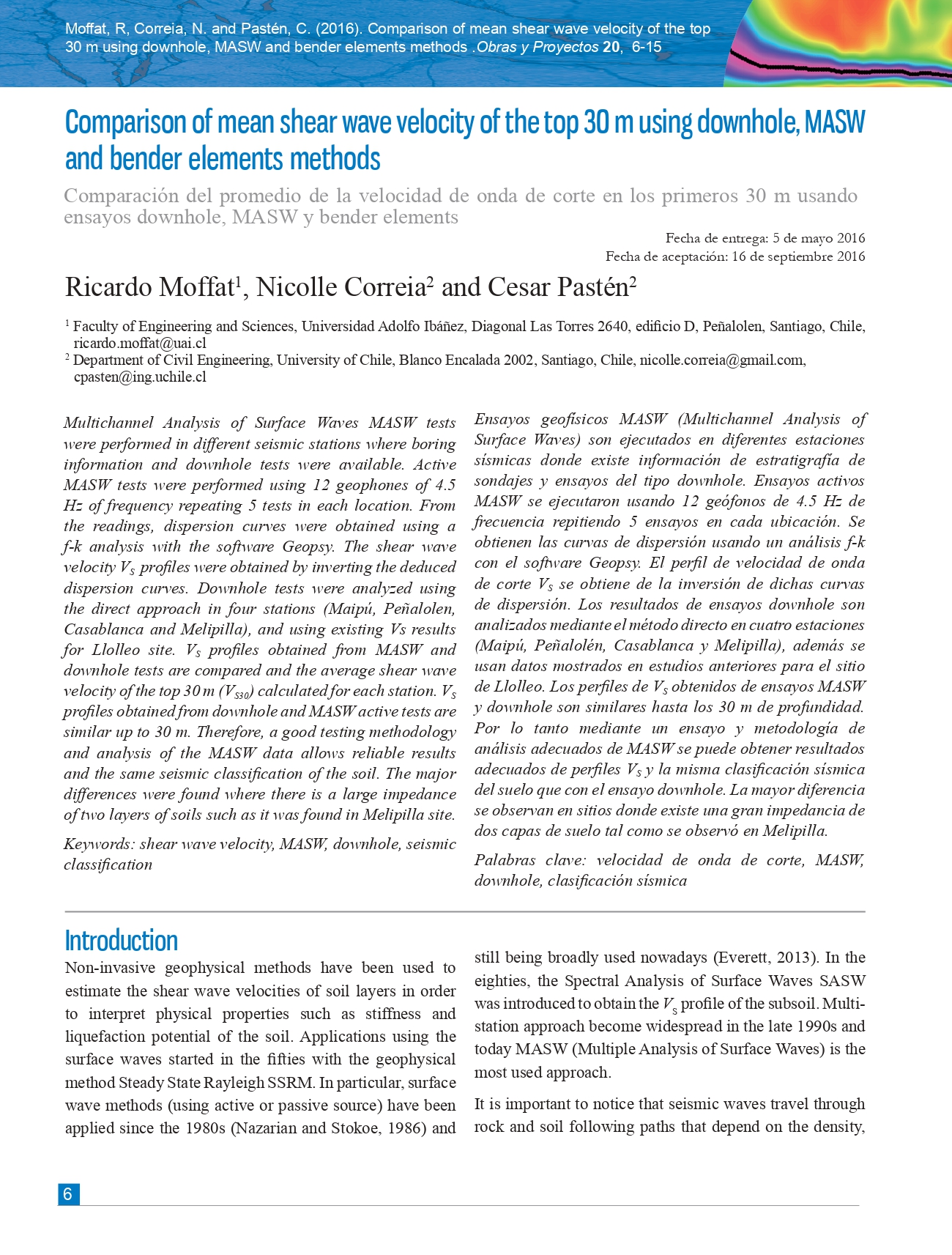Comparison of mean shear wave velocity of the top 30 m using downhole, MASW and bender elements methods
DOI:
https://doi.org/10.4067/S0718-28132016000200001Keywords:
shear wave velocity, MASW, downhole, seismic classificationAbstract
Multichannel Analysis of Surface Waves MASW tests were performed in different seismic stations where boring information and downhole tests were available. Active MASW tests were performed using 12 geophones of 4.5 Hz of frequency repeating 5 tests in each location. From the readings, dispersion curves were obtained using a f-k analysis with the software Geopsy. The shear wave velocity VS profiles were obtained by inverting the deduced dispersion curves. Downhole tests were analyzed using the direct approach in four stations (Maipú, Peñalolen, Casablanca and Melipilla), and using existing Vs results for Llolleo site. VS profiles obtained from MASW and downhole tests are compared and the average shear wave velocity of the top 30 m (VS30) calculated for each station. VS profiles obtained from downhole and MAS Wactive tests are similar up to 30 m. Therefore, a good testing methodology and analysis of the MASW data allows reliable results and the same seismic classification of the soil. The major differences were found where there is a large impedance of two layers of soils such as it was found in Melipilla site.
References
ASTM (2014). Standard test methods for downhole seismic testing, ASTM D7400. West Conshohocken, PA., USA
Biot, M.A. (1962). Mechanics of deformation and acoustic propagation in porous media. Journal of Applied Physics 33(4), 1482-1498. https://doi.org/10.1063/1.1728759
Boroschek, R.L., Yañez, F., Bejarano, I., Molnar, S. and Torres, A. (2012). Geotechnical characterization University of Chile strong motion accelerograph stations. University of Chile
Dobry, R., Borcherdt, R.D., Crouse, C.B., Idriss, I.M., Joyner, W.B., Martin, G.R., Power, M.S., Rinne, E.E. and Seed, R.B. (2000). New site coefficients and site classification system used in recent building seismic code provisions. Earthquake Spectra 16(1), 41-67. https://doi.org/10.1193/1.1586082
Everett, M.E. (2013). Near-surface applied geophysics. Cambridge University Press
Foti, S., Lai, C.G., Rix, G.J. and Strobbia, C. (2014). Surface wave methods for near-surface site characterization. CRC Press
Kim, D.S., Bang, E.S. and Kim, W.C. (2004). Evaluation of various downhole data reduction methods for obtaining reliable Vs profiles. Geotechnical Testing Journal 27(6), 1-13. https://doi.org/10.1520/GTJ11811
Lee, J.S. and Santamarina, J.C. (2005). Bender elements: Performance and signal interpretation. Journal of Geotechnical and Geoenvironmental Engineering 131(9), 1063-1070. https://doi.org/10.1061/(ASCE)1090-0241(2005)131:9(1063)
Leong, E.C., Rahardjo, H., and Yeo, S.H. (2005). Measuring shear wave velocity using bender elements. Geotechnical Testing Journal 28(5), 1-11. https://doi.org/10.1520/GTJ12196
Nazarian, S. and Stokoe, K.H. (1986). Use of surface waves in pavement evaluation. Transportation Research Record 1070, 132-144
Park, C.B., Miller, R.D. and Miura, H. (2002). Optimum field parameters of an MASW survey. Proceedings of the Society of Exploration Geophysicists, Japan, Tokyo, 22-23
Park, C.B., Miller, R.D. and Xia, J. (1999). Multichannel analysis of surface waves. Geophysics 64(3), 800-808. https://doi.org/10.1190/1.1444590
Penumadu, D. and Park, C.B. (2005). Multichannel analysis of surface wave (MASW) method for geotechnical site characterization. Proceedings of the Geo-Frontiers Conference, Austin, Texas
Rix, G. J., and Leipski, E.A. (1991). Accuracy and resolution of surface wave inversion: Recent advances in instrumentation, data acquisition and testing in soil dynamics. Geotechnical Special Publication no. 29, American Society of Civil Engineers, 17-23
Saragoni, G.R., Lew, M., Naeim, F., Carpenter, L.D., Youssef, N.F., Rojas, F and Adaros, M.S. (2010). Accelerographic measurements of the 27 February 2010 offshore Maule, Chile earthquake. The Structural Design of Tall and Special Buildings 19(8), 866-875. https://doi.org/10.1002/tal.673
Shirley, D.J. (1978). An improved shear wave transducer. The Journal of the Acoustical Society of America 63(5), 1643-1645. https://doi.org/10.1121/1.381866
Shirley, D.J. and Hampton, L.D. (1978). Shear-wave measurements in laboratory sediments. The Journal of the Acoustical Society of America 63(2), 607-613
Stokoe, K.H., Wright, S.G., Bay, J.A. and Roesset, J.M. (1994). Characterization of geotechnical sites by SASW method. Geophysical Characterization of Sites, IBH Oxford Press, New Delhi, India, 15-25
Tiznado, J.C. and Paillao, D. (2014). Analysis of the seismic bearing capacity of shallow foundations. Revista de la Construcción 13(2), 40-48. https://doi.org/10.4067/S0718-915X2014000200005
Verdugo, R. (2009). Amplification phenomena observed in downhole array records generated on a subductive environment. Physics of the Earth and Planetary Interiors 175(1), 63-77. https://doi.org/10.1016/j.pepi.2008.03.014

Downloads
Published
Issue
Section
License
Copyright (c) 2016 Universidad Católica de la Santísima Concepción

This work is licensed under a Creative Commons Attribution-NonCommercial 4.0 International License.







